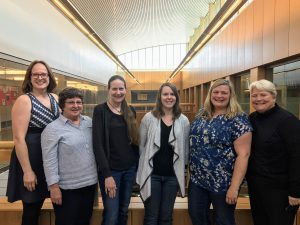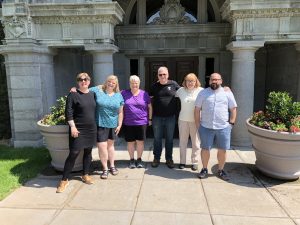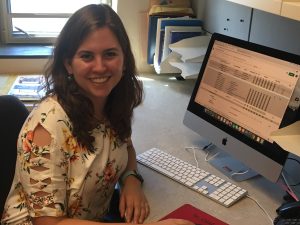Summary:
This summer our department proposed and carried out a project entitled “Diversifying Intermediate Norwegian Language Curriculum Workshop”. We gathered eleven instructors of Norwegian in the US, Canada and Norway for two weeks of curriculum development and innovation. Following these two weeks, Nancy Aarsvold, Jenna Coughlin and I spent about eight weeks further developing material and working with a student worker to create an online portal entitled Godt i gang.
Our hope is that by developing a platform that can house different modules, we will allow instructors the flexibility to tailor their instruction to the needs and interests of their students while greatly reducing the cost of their materials.
The longer version:
The Norwegian Department at St. Olaf College recognized it was time to provide intermediate Norwegian language students with a curriculum that more accurately reflects the diversity of the Norwegian experience in the past with respect to issues such as gender, class, language, and indigenous status, and the diversity of its present, which includes established immigrant communities, more recent migrants, international adoptees, refugees, and labor migration. Therefore, we developed a project proposal to invite colleagues who teach intermediate Norwegian language at colleges and universities to join us for a two-week curriculum development workshop.
During summer 2019, we developed instructional materials that can be used by Norwegian instructors and learners as a whole or in smaller, modular units. We created detailed reading guides, in-class activities and homework assignments for films, TV episodes, news articles, short stories, and novels that address the aforementioned topics. We then digitized these resources and made them freely available for use on our new web portal, Godt i gang.
This project helps us address the changing needs of students with our department’s traditional profile, which is a student with Norwegian heritage, because these students need to develop a nuanced and up-to-date understanding of Norway and its place in the wider world, as well as of the public discourse surrounding “Norwegianness,” how it is defined, and how it is used to include or exclude various members of Norwegian society. Additionally, this revision also responds to the call in the St. Olaf General Education mission statement, which is now under development, not to assume that future St. Olaf students will have a particular profile but rather to develop an inclusive curriculum that can address diverse backgrounds and needs.
By revising our curriculum, we aim to make the Norwegian department a place where students can examine questions of identity and belonging in an academic way, without assuming that they claim Norwegian identity themselves. The questions the revised curriculum will explore are intentionally broad and use Norway as an interesting case study that students can compare and contrast with the United States and other places.
The idea of creating modules on three topics related to identity makes it easy for instructors at many institutions to piece together units that are of interest to their students and are the best fit for their ability levels.
We were very fortunate to have 11 colleagues from other institutions join us for two weeks of collaborative work; each brought with them perspectives informed by the various needs and profiles of the students they serve. Together we created content that draws on diverse Norwegian perspectives and backgrounds to expose our students to the richness of Norwegian culture while facilitating and supporting their language learning.
We had so much fun diving into new resources and having discussions with our colleagues about meaningful ways we could make these new resources come alive in the classroom that we went far beyond our initial goal of creating 200 new exercises. This also means that we aren’t finished yet! To date we have about 300 new exercises in addition to 200 that we had from previous projects. Because some modules are only partially complete, we have decided to announce each module when it is ready to use.
And although it wasn’t in our initial goal of the project, we determined it was also necessary to dive further into the language development of our intermediate and advanced level students. We now have four language sections in development on the portal where students can connect their content knowledge to grammar, academic words, high frequency words and vocabulary in context.
After our workshop, Jenna Coughlin (my colleague at St. Olaf) and Nancy Aarsvold (a former colleague from St. Olaf and co-author of Sett i gang) continued to work on the development of the resources. We were then joined by Naomi Brandt (’20) who spent the majority of the summer assisting in our organizing and digitizing these resources. Naomi is an English major, Race and Ethnic Studies major and Nordic Studies Concentrator, a perfect fit for the project.
We are already using these modules in third, fifth and seventh semester courses at St. Olaf this fall and will continue to use it in fourth and sixth semester in the spring. We also have plans in the works to continue the development of this site during summer 2020, pending funding.
This project would not have been possible without the generous financial support of the To Include is To Excel grant at St. Olaf College or without our colleagues who were an integral part of its development.
Project leader: Kari Lie Dorer, St. Olaf College
Tech leader: Nancy Aarsvold, St. Olaf College (retired, 1995-2011)
Contributors include:
Margaret Hayford O’Leary, St. Olaf College (1977-2018)
Jenna Coughlin, St. Olaf College
Christine Haerter Piñero, St. Olaf College (2011-2019)
Maren Anderson Johnson, Luther College
Melissa Gjellstad, University of North Dakota, Grand Forks
Ingrid Urberg, Augustana Campus, University of Alberta
Claudia Berguson, Pacific Lutheran University (retired)
Inger Egebakken, The International Summer School, University of Oslo, Norway
Benjamin Bigelow, University of Minnesota, Twin Cities
Steven Finney, University of North Dakota, Grand Forks
Hanna Zmijewska-Emerson, University of Minnesota, Twin Cities
Naomi Brandt, student worker extraordinaire




